
Of the current test methods for testing FTTx (Fibre to the ‘x’, with x being a placeholder for various end-points) and PON (passive optical network) installations, OLTS, using an optical loss test set (optical power meter and light source) to characterise a link is easy; however it has one major limitation: it cannot locate the problems on the link. Furthermore, an OLTS requires two units and two technicians, thus increasing OPEX.
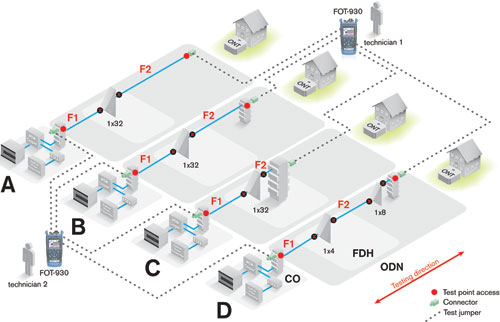
The most popular test method during construction and in certifying FTTX/PON installations is an OTDR (optical time domain reflectometer). A well trained and skilled optical technician can identify and locate problems on a link, using multiple acquisitions with different OTDR test settings and after various manual OTDR trace comparisons.
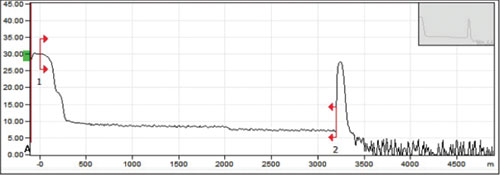
The shift from copper to fibre and the explosion of fibre deployments has created a shortage of skilled and experienced technicians. Combine this with budget constraints, lack of credible training facilities, practical experience and the result is an increased risk of improper testing, misdiagnoses, unusable OTDR results and repeat repairs/truck rolls.
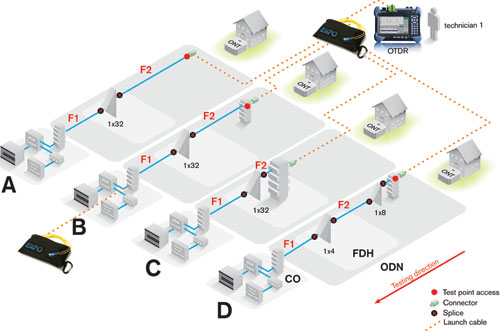
The complexity of a PON/FTTx network requires skilled optical technicians to set different acquisition parameters on the OTDR to get the required information. Single OTDR measurement and auto test settings on today’s OTDRs are incapable of fully characterising this type of network.
To overcome this limitation, skilled technicians perform multiple additional acquisitions on the OTDR with other parameters to fully characterise the link.
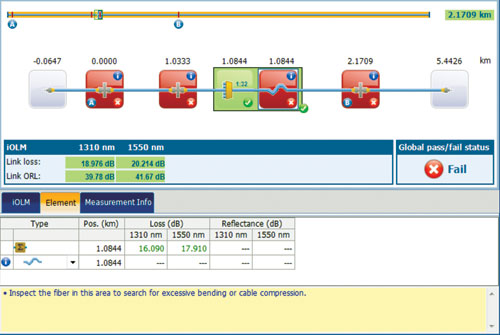
Portable applications
EXFO’s new test solution is an ‘intelligent’ OTDR. Essentially it is a software application that runs on the test unit that is able to set and take multiple and variable acquisitions, then analyse the information to generate a detailed linear diagram about every element on the link, in a single-button operation, providing maximum simplicity for expert-level link characterisation.
This new test method makes every technician a fibre-optics expert, whether they are testing in the field or from the central office. Plus, it does not require the parameter settings used in traditional OTDR testing, which means no distance, pulse width or averaging time setting with detection threshold setting required.
iOLM (intelligent Optical Link Mapper) technology stems from the need to create optimal testing technology for PON networks, as this is the most challenging network to test because of its short link lengths and many closely spaced elements, such as splices, connectors and splitters.
As shown in Table 1, the maximum IL difference between iOLM and the reference method (PM/LS) is 0,64 dB, which compares favourably to the OLTS method. Based on the PM/LS and the OLTS results, an experienced technician could have suspected a macrobend on the line because the difference in loss is more than 1 dB between 1310 and 1550 nm.

However, he would have no clue as to the location of the macrobend. He could therefore use an OTDR and a different combination of pulse widths to find the macrobend himself. With iOLM any technician will be able to clearly see that there is a macrobend immediately after the splitter (see Figure 5 showing a test conducted from ONT to OLT).

The test method is a one-end, single-unit testing method with the ability to provide clear diagnostics and discovered elements in a single view.
Comparing ORL measurements (Table 2), the maximum difference between the ORL meter and iOLM is 0,84 dB, which is small enough to locate any ORL problem.
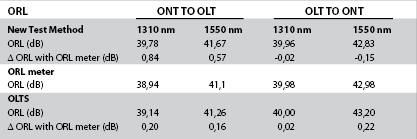
So what is causing an ORL issue on the line?
This is caused by connector reflectance, but according to the ORL results, we are below the 32 dB threshold. Now, if we look at the results in Figure 6, we can see that there is one highly reflective connector that needs to be fixed (exceeds the -55 dB threshold).

This is what we are looking for when testing with an ORL meter (or OLTS) in both directions. We want to know the direction of the high ORL because that is where the high reflective connector is. Obviously, we would have missed it with the ORL meter or the OLTS, providing a clear advantage for the iOLM.
For more information contact Chris Nel, Lambda Test Equipment, +27 (0)12 349 1341, [email protected], www.lambdatest.co.za
| Tel: | +27 12 349 1341 |
| Email: | [email protected], [email protected] |
| www: | www.lambdatest.co.za |
| Articles: | More information and articles about Lambda Test |

© Technews Publishing (Pty) Ltd | All Rights Reserved